Abstract
Selective autonomic blockade with intravenous propranolol, practolol, atropine, and combined atropine-propranolol was utilized to elucidate the role of the autonomic nervous system in the hemodynamic responses in young adult male volunteers to handgrip sustained at 30% of maximal voluntary contraction for 3 min. The initial 30 s of the tachycardia response was found to be mediated by withdrawal of vagal dominance, as evidenced by blockade of this response by prior atropinization. The mid and late portion of the heart rate response curve was demonstrated to be sympathetic in origin, since it was unaffected by atropine, but was suppressed by combined atropine-propranolol blockade. Sympathetic stimulation appears to be a secondary mechanism for increasing the heart rate, however, as it becomes operative only after the first mechanism of vagal withdrawal has been utilized. This was confirmed by the finding that beta adrenergic receptor blockade alone had little effect on the heart rate response curve.
The pressor response to handgrip was accompanied by increased cardiac output and no change in calculated systemic vascular resistance. After propranolol, handgrip resulted in increased peripheral resistance and an equivalent rise in arterial pressure, but no increase in cardiac output. It was concluded that the increase in resistance was the result of sympathetically induced vasoconstriction. This response was shown to be independent of peripheral beta adrenergic receptor blockade by the use of practolol, a cardio-selective beta adrenergic receptor-blocking drug which caused identical hemodynamic responses to those observed after propranolol.
Left ventricular ejection time (corrected for heart rate) was prolonged by handgrip. The increased afterload imposed on the left ventricle by sustained handgrip may explain the prolongation of ejection time index. Preejection period was prolonged by SHG after propranolol and shortened after atropine. In addition to confirming the previously defined role of the parasympathetic nervous system, this study delineates the role of the sympathetic nervous system in the heart rate and pressor responses to sustained handgrip.
Full text
PDF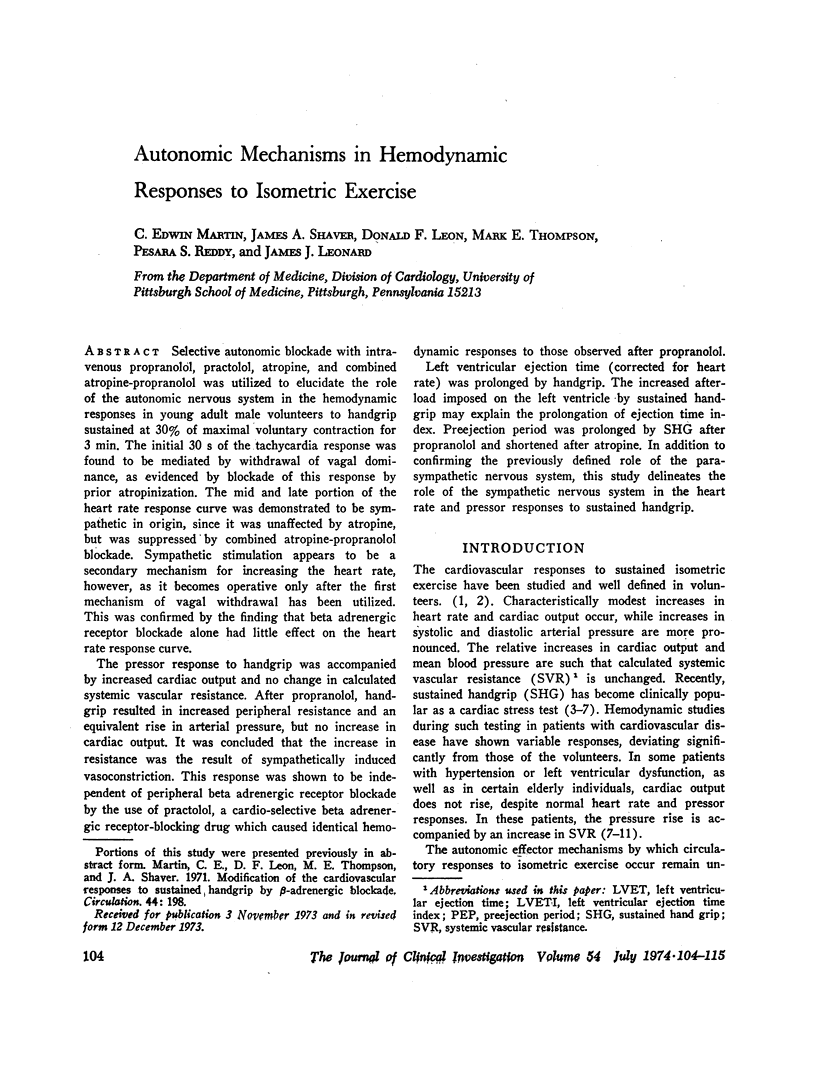
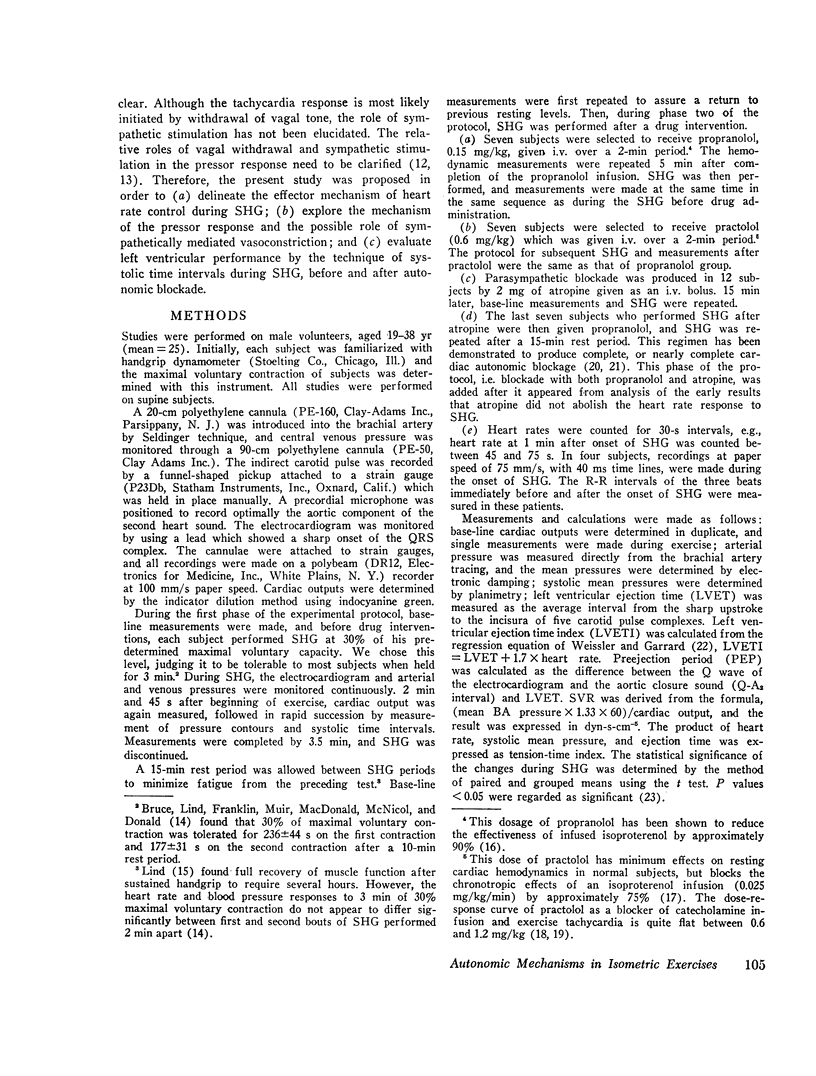

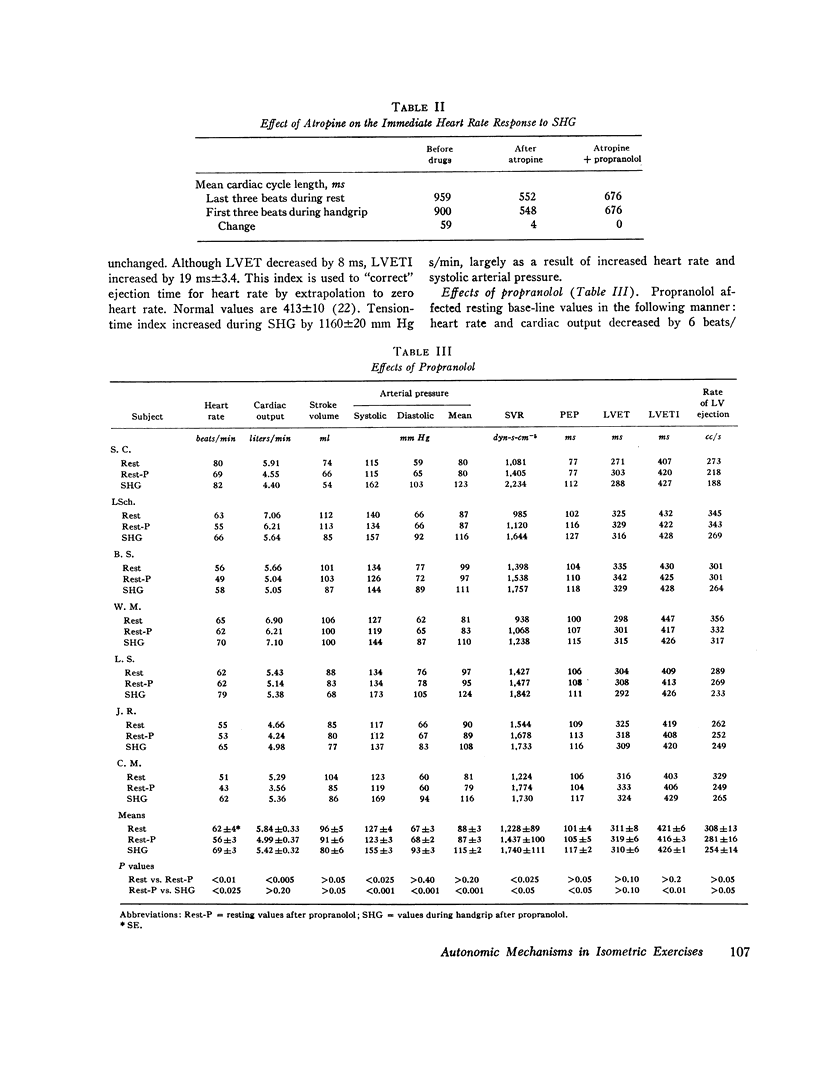
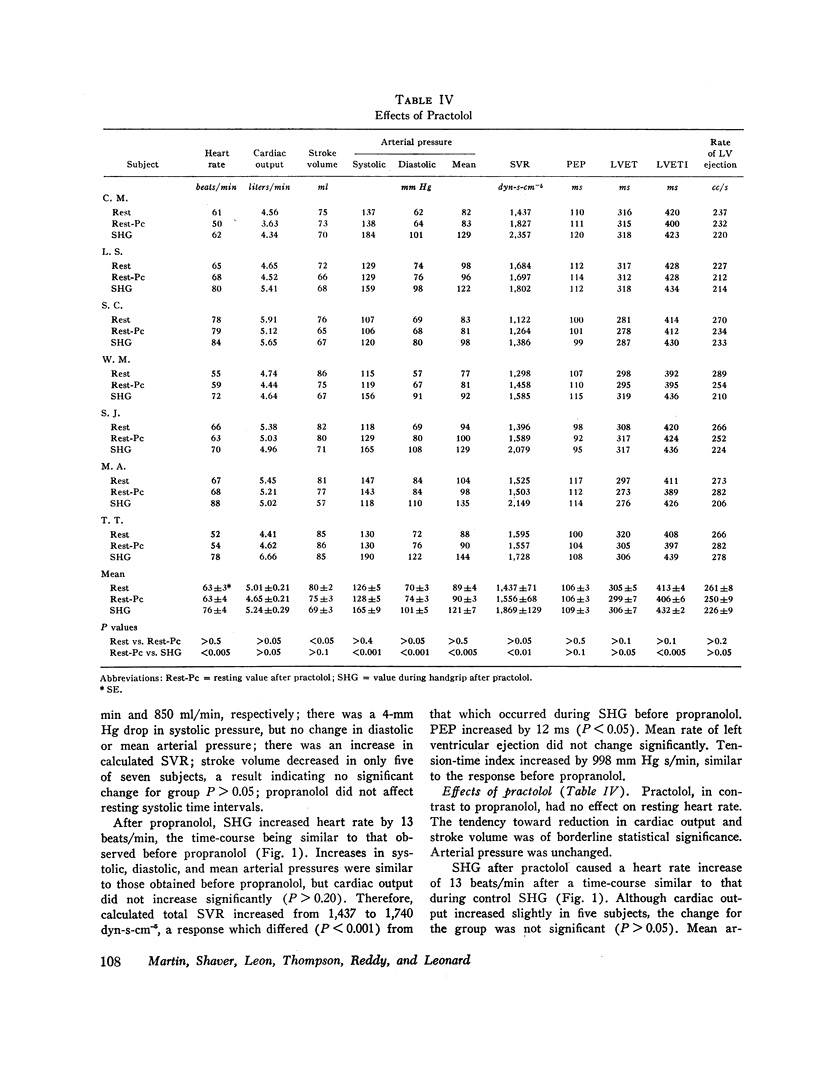
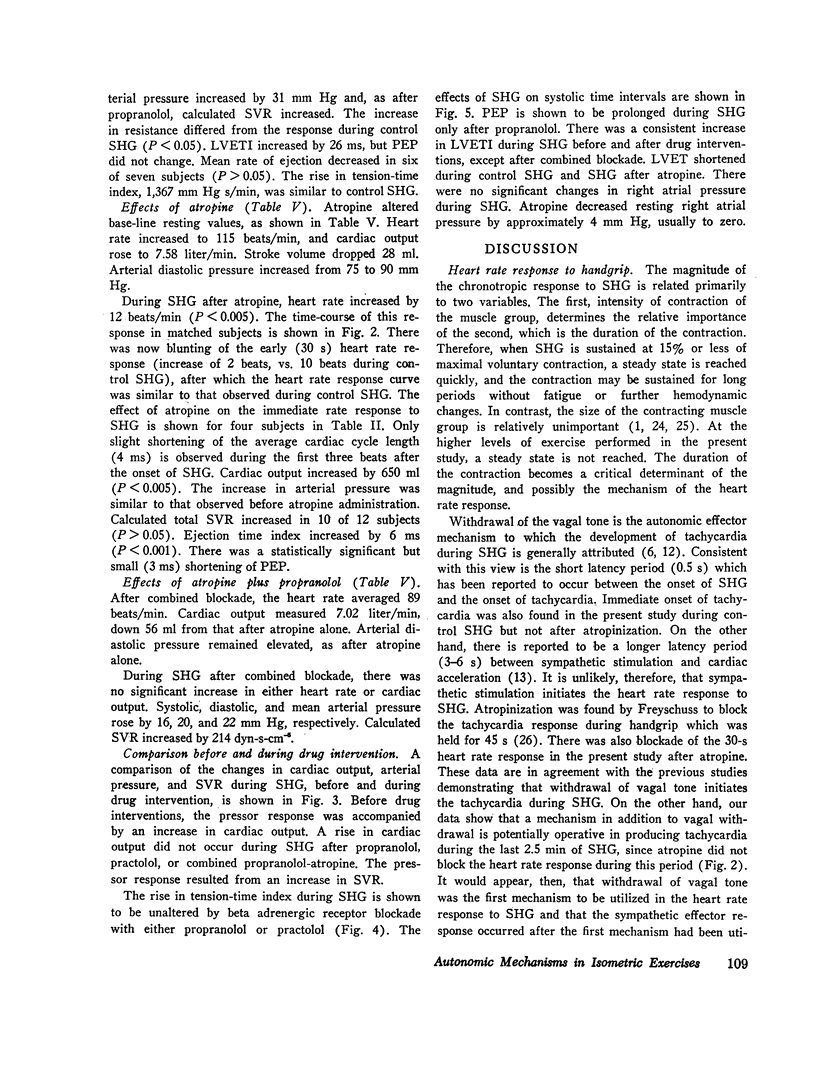
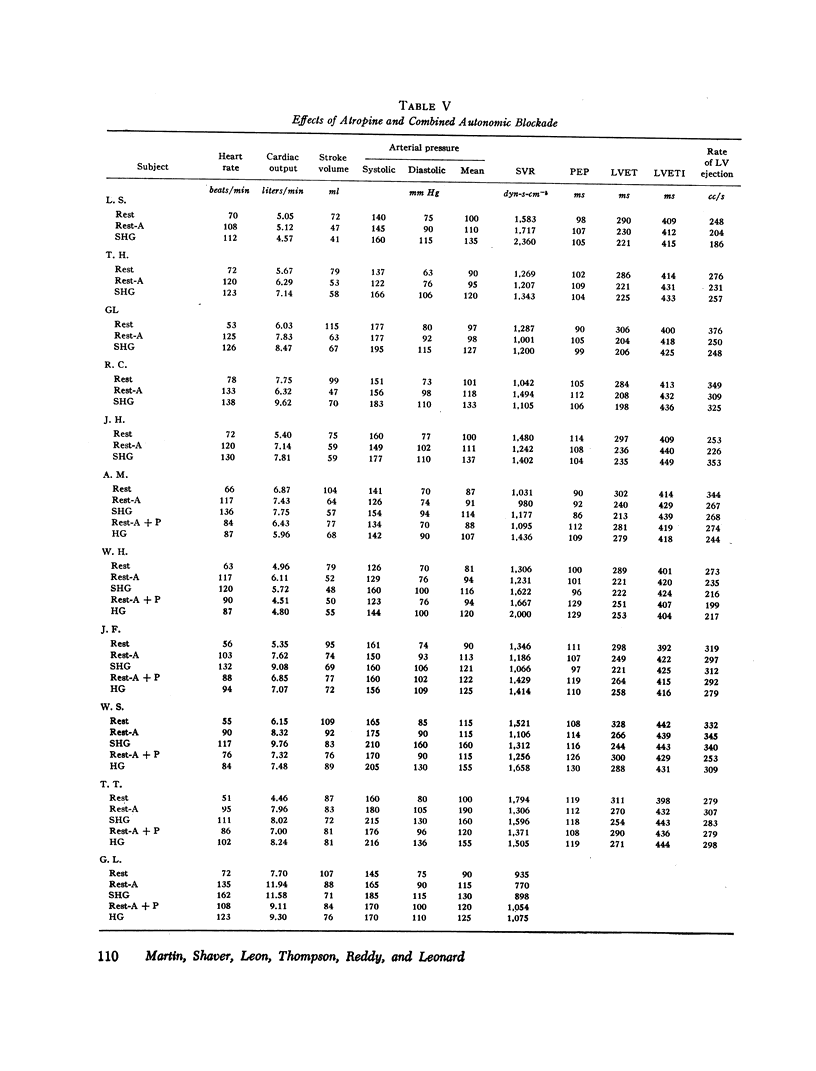
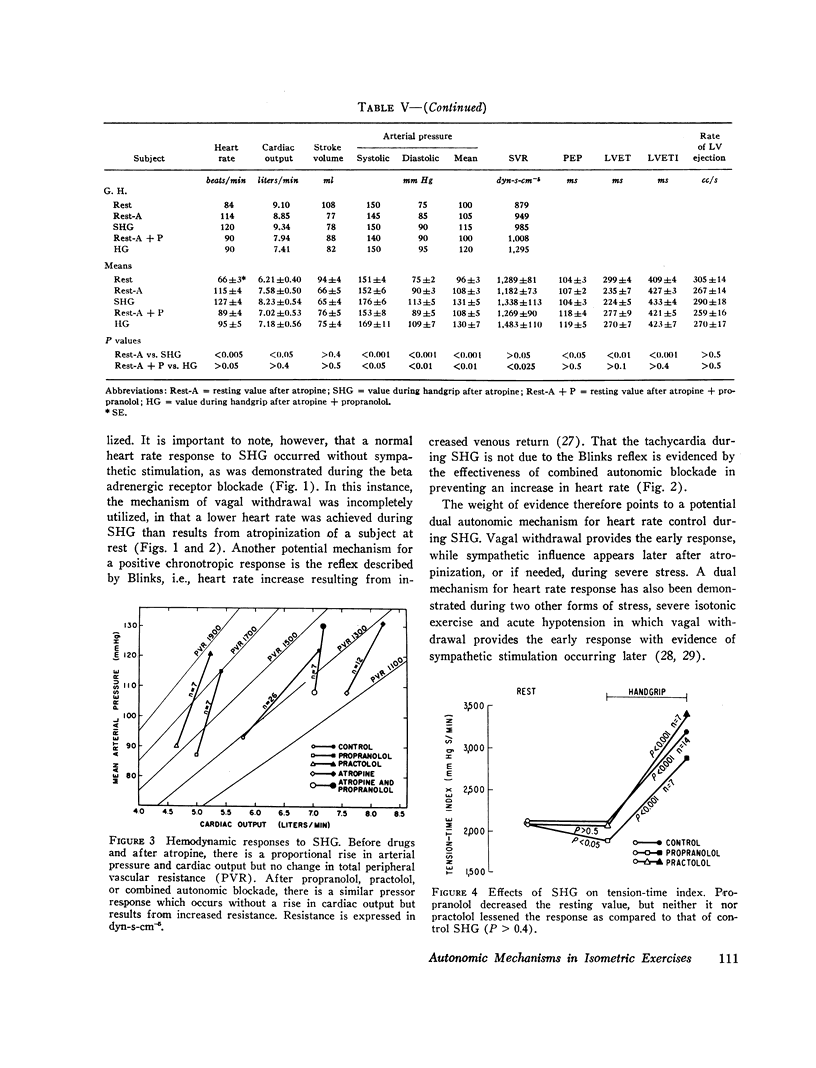
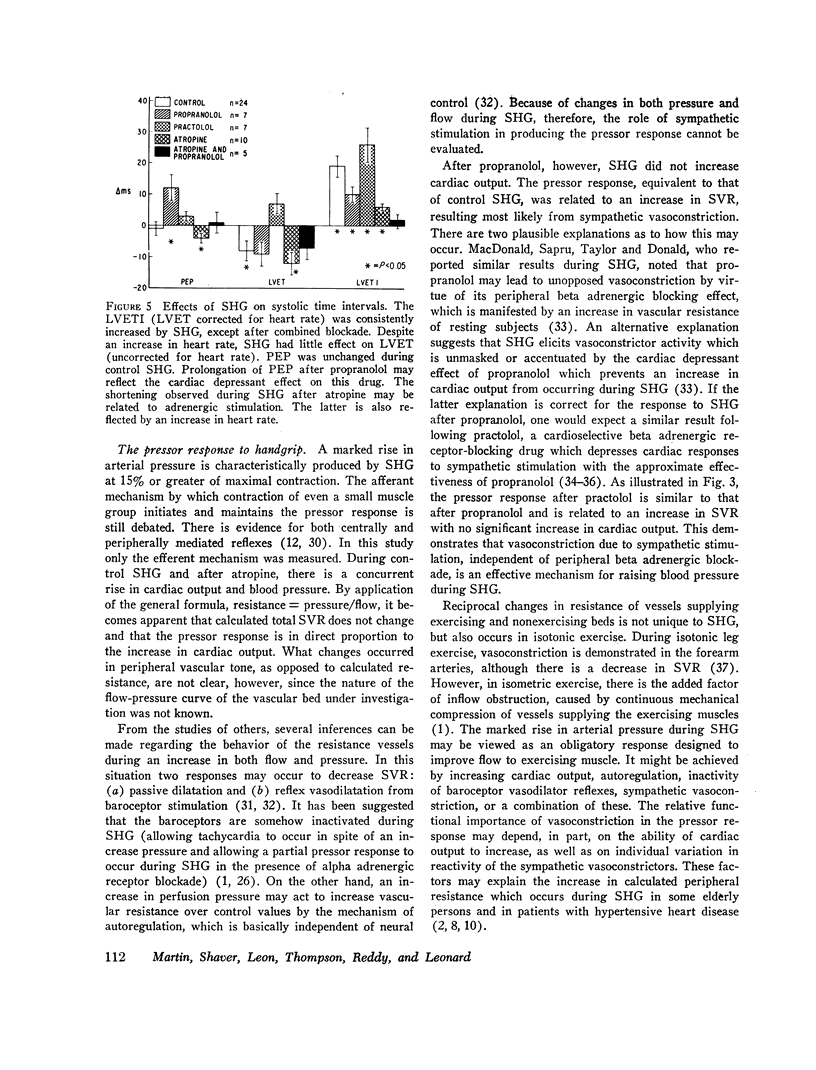
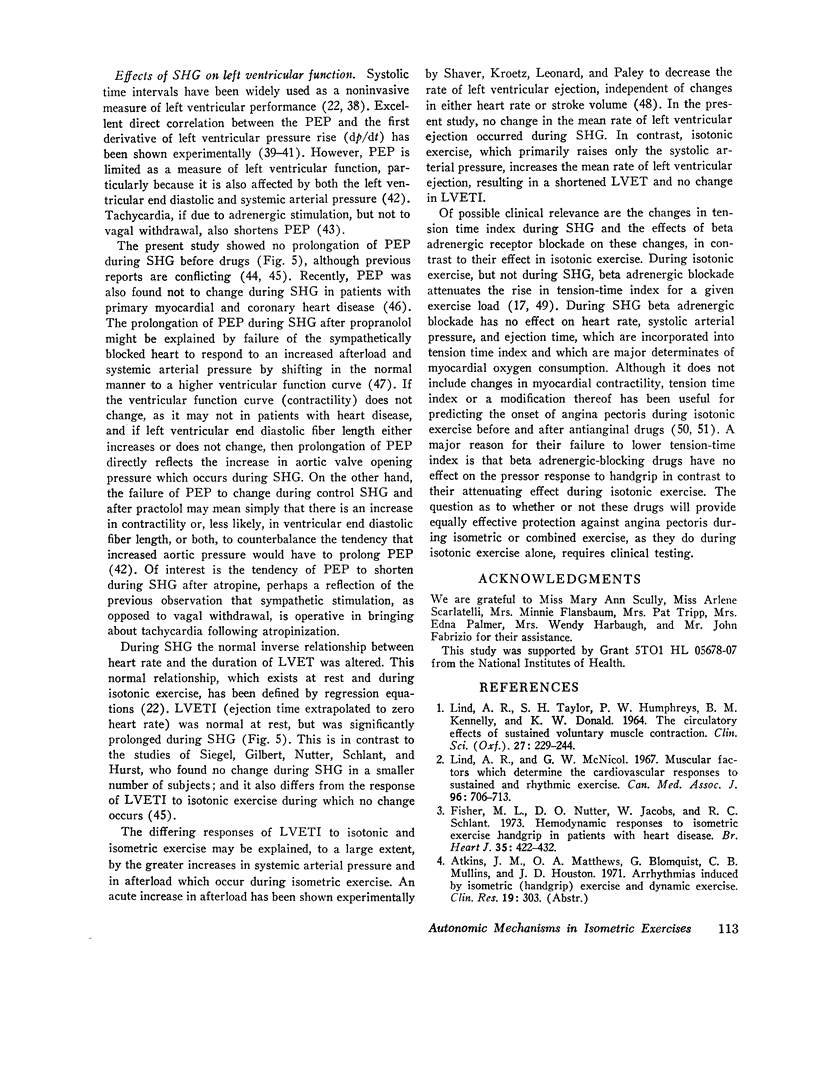
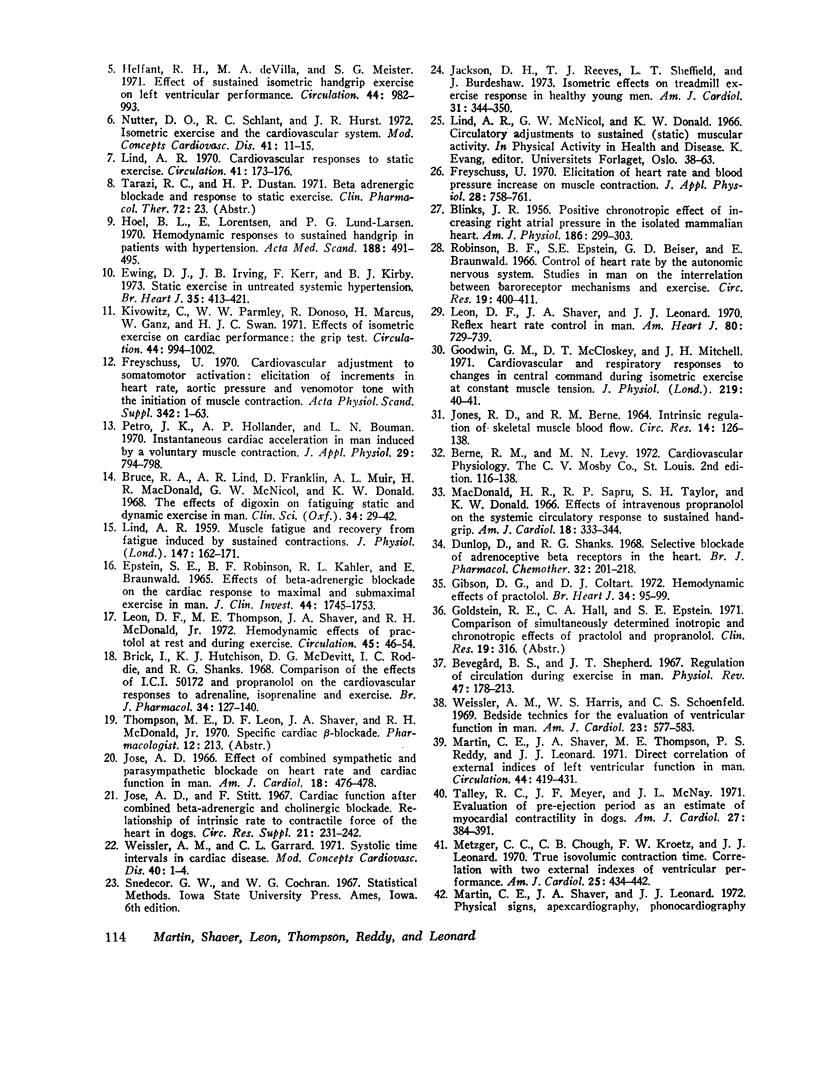
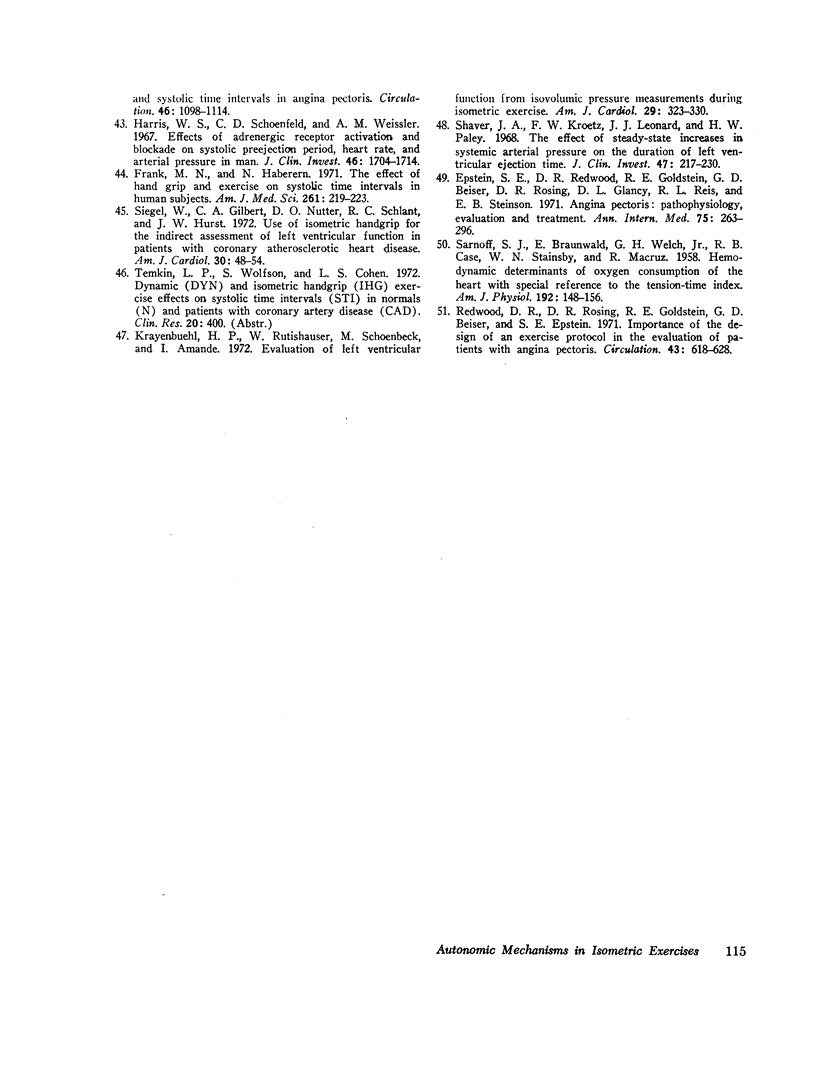
Selected References
These references are in PubMed. This may not be the complete list of references from this article.
- Angina pectoris: pathophysiology, evaluation, and treatment. Ann Intern Med. 1971 Aug;75(2):263–296. doi: 10.7326/0003-4819-75-2-263. [DOI] [PubMed] [Google Scholar]
- BLINKS J. R. Positive chronotropic effect of increasing right atrial pressure in the isolated mammalian heart. Am J Physiol. 1956 Aug;186(2):299–303. doi: 10.1152/ajplegacy.1956.186.2.299. [DOI] [PubMed] [Google Scholar]
- Bevegård B. S., Shepherd J. T. Regulation of the circulation during exercise in man. Physiol Rev. 1967 Apr;47(2):178–213. doi: 10.1152/physrev.1967.47.2.178. [DOI] [PubMed] [Google Scholar]
- Brick I., Hutchison K. J., McDevitt D. G., Roddie I. C., Shanks R. G. Comparison of the effects of I.C.I. 50172 and propranolol on the cardiovascular responses to adrenaline, isoprenaline and exercise. Br J Pharmacol. 1968 Sep;34(1):127–140. doi: 10.1111/j.1476-5381.1968.tb07956.x. [DOI] [PMC free article] [PubMed] [Google Scholar]
- Dunlop D., Shanks R. G. Selective blockade of adrenoceptive beta receptors in the heart. Br J Pharmacol Chemother. 1968 Jan;32(1):201–218. doi: 10.1111/j.1476-5381.1968.tb00444.x. [DOI] [PMC free article] [PubMed] [Google Scholar]
- Epstein S., Robinson B. F., Kahler R. L., Braunwald E. Effects of beta-adrenergic blockade on the cardiac response to maximal and submaximal exercise in man. J Clin Invest. 1965 Nov;44(11):1745–1753. doi: 10.1172/JCI105282. [DOI] [PMC free article] [PubMed] [Google Scholar]
- Ewing D. J., Irving J. B., Kerr F., Kirby B. J. Static exercise in untreated systemic hypertension. Br Heart J. 1973 Apr;35(4):413–421. doi: 10.1136/hrt.35.4.413. [DOI] [PMC free article] [PubMed] [Google Scholar]
- Fisher M. L., Nutter D. O., Jacobs W., Schlant R. C. Haemodynamic responses to isometric exercise (handgrip) in patients with heart disease. Br Heart J. 1973 Apr;35(4):422–432. doi: 10.1136/hrt.35.4.422. [DOI] [PMC free article] [PubMed] [Google Scholar]
- Frank M. N., Haberern N. The effect of hand grip and exercise on systolic time intervals in human subjects. Am J Med Sci. 1971 Apr;261(4):219–223. doi: 10.1097/00000441-197104000-00006. [DOI] [PubMed] [Google Scholar]
- Freyschuss U. Cardiovascular adjustment to somatomotor activation. The elicitation of increments in heart rate, aortic pressure and venomotor tone with the initiation of muscle contraction. Acta Physiol Scand Suppl. 1970;342:1–63. [PubMed] [Google Scholar]
- Freyschuss U. Elicitation of heart rate and blood pressure increase on muscle contraction. J Appl Physiol. 1970 Jun;28(6):758–761. doi: 10.1152/jappl.1970.28.6.758. [DOI] [PubMed] [Google Scholar]
- Gibson D. G., Coltart D. J. Haemodynamic effects of practolol. Br Heart J. 1972 Jan;34(1):95–99. doi: 10.1136/hrt.34.1.95. [DOI] [PMC free article] [PubMed] [Google Scholar]
- Harris W. S., Schoenfeld C. D., Weissler A. M. Effects of adrenergic receptor activation and blockade on the systolic preejection period, heart rate, and arterial pressure in man. J Clin Invest. 1967 Nov;46(11):1704–1714. doi: 10.1172/JCI105661. [DOI] [PMC free article] [PubMed] [Google Scholar]
- Hoel B. L., Lorentsen E., Lund-Larsen P. G. Haemodynamic responses to sustained hand-grip in patients with hypertension. Acta Med Scand. 1970 Dec;188(6):491–495. doi: 10.1111/j.0954-6820.1970.tb08074.x. [DOI] [PubMed] [Google Scholar]
- JONES R. D., BERNE R. M. INTRINSIC REGULATION OF SKELETAL MUSCLE BLOOD FLOW. Circ Res. 1964 Feb;14:126–138. doi: 10.1161/01.res.14.2.126. [DOI] [PubMed] [Google Scholar]
- Jackson D. H., Reeves T. J., Sheffield L. T., Burdeshaw J. Isometric effects on treadmill exercise response in healthy young men. Am J Cardiol. 1973 Mar;31(3):344–350. doi: 10.1016/0002-9149(73)90266-x. [DOI] [PubMed] [Google Scholar]
- Jose A. D. Effect of combined sympathetic and parasympathetic blockade on heart rate and cardiac function in man. Am J Cardiol. 1966 Sep;18(3):476–478. doi: 10.1016/0002-9149(66)90073-7. [DOI] [PubMed] [Google Scholar]
- Kivowitz C., Parmley W. W., Donoso R., Marcus H., Ganz W., Swan H. J. Effects of isometric exercise on cardiac performance. The grip test. Circulation. 1971 Dec;44(6):994–1002. doi: 10.1161/01.cir.44.6.994. [DOI] [PubMed] [Google Scholar]
- Krayenbuehl H. P., Rutishauser W., Schoenbeck M., Amende I. Evaluation of left ventricular function from isovolumic pressure measurements during isometric exercise. Am J Cardiol. 1972 Mar;29(3):323–330. doi: 10.1016/0002-9149(72)90526-7. [DOI] [PubMed] [Google Scholar]
- LIND A. R. Muscle fatigue and recovery from fatigue induced by sustained contractions. J Physiol. 1959 Jun 23;147(1):162–171. doi: 10.1113/jphysiol.1959.sp006231. [DOI] [PMC free article] [PubMed] [Google Scholar]
- LIND A. R., TAYLOR S. H., HUMPHREYS P. W., KENNELLY B. M., DONALD K. W. THE CIRCULATIORY EFFECTS OF SUSTAINED VOLUNTARY MUSCLE CONTRACTION. Clin Sci. 1964 Oct;27:229–244. [PubMed] [Google Scholar]
- Leon D. F., Shaver J. A., Leonard J. J. Reflex heart rate control in man. Am Heart J. 1970 Dec;80(6):729–739. doi: 10.1016/0002-8703(70)90133-x. [DOI] [PubMed] [Google Scholar]
- Leon D. F., Thompson M. E., Shaver J. A., McDonald R. H., Jr Hemodynamic effects of practolol at rest and during exercise. Circulation. 1972 Jan;45(1):46–54. doi: 10.1161/01.cir.45.1.46. [DOI] [PubMed] [Google Scholar]
- Lind A. R. Cardiovascular responses to static exercise. (Isometrics, anyone?). Circulation. 1970 Feb;41(2):173–176. doi: 10.1161/01.cir.41.2.173. [DOI] [PubMed] [Google Scholar]
- Lind A. R., McNicol G. W. Muscular factors which determine the cardiovascular responses to sustained and rhythmic exercise. Can Med Assoc J. 1967 Mar 25;96(12):706–715. [PMC free article] [PubMed] [Google Scholar]
- MacDonald H. R., Sapru R. P., Taylor S. H., Donald K. W. Effect of intravenous propranolol on the systemic circulatory response to sustained handgrip. Am J Cardiol. 1966 Sep;18(3):333–344. doi: 10.1016/0002-9149(66)90051-8. [DOI] [PubMed] [Google Scholar]
- Martin C. E., Shaver J. A., Leonard J. J. Physical signs, apexcardiography, phonocardiography, and systolic time intervals in angina pectoris. Circulation. 1972 Dec;46(6):1098–1114. doi: 10.1161/01.cir.46.6.1098. [DOI] [PubMed] [Google Scholar]
- Martin C. E., Shaver J. A., Thompson M. E., Reddy P. S., Leonard J. J. Direct correlation of external systolic time intervals with internal indices of left ventricular function in man. Circulation. 1971 Sep;44(3):419–431. doi: 10.1161/01.cir.44.3.419. [DOI] [PubMed] [Google Scholar]
- Metzger C. C., Chough C. B., Kroetz F. W., Leonard J. J. True isovolumic contraction time. Its correlation with two external indexes of ventricular performance. Am J Cardiol. 1970 Apr;25(4):434–442. doi: 10.1016/0002-9149(70)90010-x. [DOI] [PubMed] [Google Scholar]
- Nutter D. O., Schlant R. C., Hurst J. W. Isometric exercise and the cardiovascular system. Mod Concepts Cardiovasc Dis. 1972 Mar;41(3):11–15. [PubMed] [Google Scholar]
- Petro J. K., Hollander A. P., Bouman L. N. Instantaneous cardiac acceleration in man induced by a voluntary muscle contraction. J Appl Physiol. 1970 Dec;29(6):794–798. doi: 10.1152/jappl.1970.29.6.794. [DOI] [PubMed] [Google Scholar]
- Redwood D. R., Rosing D. R., Goldstein R. E., Beiser G. D., Epstein S. E. Importance of the design of an exercise protocol in the evaluation of patients with angina pectoris. Circulation. 1971 May;43(5):618–628. doi: 10.1161/01.cir.43.5.618. [DOI] [PubMed] [Google Scholar]
- Robinson B. F., Epstein S. E., Beiser G. D., Braunwald E. Control of heart rate by the autonomic nervous system. Studies in man on the interrelation between baroreceptor mechanisms and exercise. Circ Res. 1966 Aug;19(2):400–411. doi: 10.1161/01.res.19.2.400. [DOI] [PubMed] [Google Scholar]
- SARNOFF S. J., BRAUNWALD E., WELCH G. H., Jr, CASE R. B., STAINSBY W. N., MACRUZ R. Hemodynamic determinants of oxygen consumption of the heart with special reference to the tension-time index. Am J Physiol. 1958 Jan;192(1):148–156. doi: 10.1152/ajplegacy.1957.192.1.148. [DOI] [PubMed] [Google Scholar]
- Shaver J. A., Kroetz F. W., Leonard J. J., Paley H. W. The effect of steady-state increases in systemic arterial pressure on the duration of left ventricular ejection time. J Clin Invest. 1968 Jan;47(1):217–230. doi: 10.1172/JCI105711. [DOI] [PMC free article] [PubMed] [Google Scholar]
- Siegel W., Gilbert C. A., Nutter D. O., Schlant R. C., Hurst J. W. Use of isometric handgrip for the indirect assessment of left ventricular function in patients with coronary atherosclerotic heart disease. Am J Cardiol. 1972 Jul 11;30(1):48–54. doi: 10.1016/0002-9149(72)90124-5. [DOI] [PubMed] [Google Scholar]
- Talley R. C., Meyer J. F., McNay J. L. Evaluation of the pre-ejection period as an estimate of myocardial contractility in dogs. Am J Cardiol. 1971 Apr;27(4):384–391. doi: 10.1016/0002-9149(71)90435-8. [DOI] [PubMed] [Google Scholar]
- Weissler A. M., Garrard C. L., Jr Systolic time intervals in cardiac disease. I. Mod Concepts Cardiovasc Dis. 1971 Jan;40(1):1–4. [PubMed] [Google Scholar]
- Weissler A. M., Harris W. S., Schoenfeld C. D. Bedside technics for the evaluation of ventricular function in man. Am J Cardiol. 1969 Apr;23(4):577–583. doi: 10.1016/0002-9149(69)90012-5. [DOI] [PubMed] [Google Scholar]


